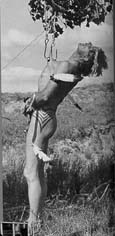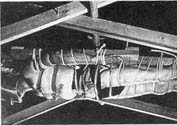Fakir Musafar
Fakir Musafar (born Roland Loomis, August 10, 1930) is a performance artist and early proponent of the modern primitive movement. He has experimented with and taught body modification techniques such as body piercing, tightlacing, scarification, tattooing, and flesh hook suspension. He is involved in the BDSM, kink and fetish communities.
Early life
At age four Musafar claimed to have experienced dreams of past lives. He reports having given himself his first body piercing when he was twelve. Based on his viewing of anthropological works he first performed his idea of a flesh hook suspension in 1966 or 1967. As an adult he gave himself the name "Fakir Musafar".Career
Musafar has documented his experiences in writing about and teaching others "body play". In the early 1990s, Musafar appeared in mainstream media shows like NBC's Faith Daniels Show, CBS's People Are Talking, CNN's Earth Matters and Discovery Channel's (Beyond Bizarre). In 1998 He produced documentary segments for London Weekend Television's Southbank Show and Playboy Television's "Sexcetera". In 2000, 2001 and 2003 he has appeared in documentaries for The Learning Channel (Human Canvas Part I and Part II), TBS, FX Channel and Discovery Channel plus a major appearance in the 2001 documentary film "Modern Tribalism". In 2004 became a spokesperson for the National Geographic Channel's Taboo (TV series) and has expressed "radical contemporary" views on body rituals on the Travel Channel's "Eye of the Beholder" series hosted by Serena Yang.Musafar's writing and photography appears in Theater Journal, Bizarre magazine (fetish and SM exploration), Skin Two and PFIQ (Piercing Fan International Quarterly). He has lectured and performed at London's Institute of Contemporary Arts (Rapture Series, 1995); Copenhagen's International Seminar on BODY:Ritual-Manipulation (1995) and Lisbon, Portugal's Festival Atlantico (1997). His photographic art was recently exhibited at the Fahey/Klein Gallery in Los Angeles.
In 1999 his performance group performed "Metamorphosis" at the Los Angeles Fetish Ball as well as for close friend Annie Sprinkle's Benefit Show at the Cowell Theater in San Francisco after her houseboat and archives were destroyed by fire.
Musafar continues to speak at colleges and universities and to New Age and other special interest groups. Musafar is considered a Master piercer with over 40 years experience in the body arts. He is also the founder and director of the School for Professional Body Piercing, the first in America.
Musafar is featured in Modern Primitives, published by RE/Search, and in the full-length documentary Dances Sacred and Profane. He also appears in the movie Modify and Charles Gatewood's documentary, Dances Sacred and Profane.
"Perfect Gentleman, Self Portrait", 1959, Ed. 25
Fakir Musafar ha l’aspetto di
un comune uomo d’affari americano, e infatti è
account executive di una grande agenzia pubblicitaria. Al
contempo, però, è anche il capo spirituale di quel
movimento che egli stesso ha definito "Modern
Primitives". Il nome l’ha
preso da un vero fachiro indiano vissuto nel XIX secolo
che, si racconta, vagò per 18 anni portandosi spade e
lance infilzate nella pelle e cercando di trasmettere i
misteri del corpo e della psiche. E proprio per seguire
in toto le orme di questo santone, Fakir ha deciso di
sperimentare su di sé le deformazioni corporali al fine
di esplorare gli stadi profondi del dolore fisico e
scoprire l’estasi mentale che questo può provocare.
Una simile tendenza
nel manipolare e mettere a dura prova il proprio corpo,
si manifestò in lui fin da bambino. All’età di 12
anni, infatti, Fakir diede inizio all’esplorazione
sistematica delle varie deformazioni e mutilazioni
corporali e dei riti iniziatici praticati dall’uomo
sin dai tempi antichi. Prendendo spunto da una fotografia
di un guerriero Ibitoe della Nuova Guinea - la cui
attaccatura del busto, stretta giorno e notte da una
rudimentale cintura, era stata deformata per sempre dopo
anni di atroci sofferenze - il giovane Fakir decise di
indossare una stretta fascia alternata a un corsetto
speciale da lui costruito. L’esperimento è durato
per più di trenta anni e ancora oggi, a 55 anni, il suo
giro vita vanta misure da record! A 13 anni, Fakir si
praticò il primo piercing al pene, mentre i
primi tatuaggi, sempre da solo, se
li realizzò al liceo, spinto dal desiderio irresistibile
di marchiare il suo corpo indelebilmente.
A 13 anni, Fakir si
praticò il primo piercing al pene, mentre i
primi tatuaggi, sempre da solo, se
li realizzò al liceo, spinto dal desiderio irresistibile
di marchiare il suo corpo indelebilmente.E’ Fakir stesso a spiegare che cosa sia realmente il dolore fisico e come ci si possa separare dal proprio corpo con la concentrazione: "Attraverso il dolore, la prima cosa che impari è che puoi separare la coscienza dal corpo, vale a dire la parte di te che pensa e sente può distaccarsi dalle sensazioni corporee. Sarà così possibile prendere un ago e infilarlo nella pelle perché non sei tu a sentire il dolore ma solo il tuo corpo, mentre la mente osserva il corpo che prova le sensazioni e le registra. A quel punto non si tratta più di dolore. Se impariamo a separare la nostra coscienza e la nostra attenzione dal corpo, potremo fargli provare quasi tutto senza provare dolore. Basta focalizzare l’attenzione su un determinato punto del corpo o su un punto esterno al corpo e concentrarsi. Questo si chiama "stato di alterazione".
Secondo la filosofia di Fakir, l’uomo non possiede realmente il suo corpo, poiché esso è della natura: è come una casa che abitiamo, ma di cui non siamo proprietari. Per viverci meglio siamo liberi di modificarla, abbellirla e decorarla, ma questo è tutto. Si tratta di un concetto in cui alcuni popoli, come gli aborigeni australiani, hanno sempre creduto, ma che è invece estraneo a noi occidentali.
 Fakir Musafar si è
sottoposto alla pratiche più estreme della body art: dal
letto di chiodi al restare appeso per ore e ore a degli
uncini infilati nel petto, dal restringimento del
giro-vita all’allungamento del pene. Secondo la sua
filosofia, "alle culture moderne sembra mancare
un’intera parte di vita. Dilaga l’alienazione e
la gente ha perso il contatto con le cose e con se
stessa. Serve un rimedio, e il principio base può essere
sintetizzato così: gioca con il tuo corpo e fanne ciò
che vuoi. A mio avviso la gente ha un disperato bisogno
di questi riti, ecco perché rinascono il piercing e il
tatuaggio. In un modo o nell’altro, c’è
bisogno di una cultura tribale".
Fakir Musafar si è
sottoposto alla pratiche più estreme della body art: dal
letto di chiodi al restare appeso per ore e ore a degli
uncini infilati nel petto, dal restringimento del
giro-vita all’allungamento del pene. Secondo la sua
filosofia, "alle culture moderne sembra mancare
un’intera parte di vita. Dilaga l’alienazione e
la gente ha perso il contatto con le cose e con se
stessa. Serve un rimedio, e il principio base può essere
sintetizzato così: gioca con il tuo corpo e fanne ciò
che vuoi. A mio avviso la gente ha un disperato bisogno
di questi riti, ecco perché rinascono il piercing e il
tatuaggio. In un modo o nell’altro, c’è
bisogno di una cultura tribale".Musafar è anche il curatore di "Body Play", una rivista specializzata su quanto di più strano è possibile fare con e sul proprio corpo: una rivista di culto unica al mondo.
Clothes Pin Fans, 1944 (Age 14).
Fakir's early bodymod experiments involved temporary piercing of septum and lobes, plus elaborate body fans made of his mother's spring-type clothes pins.
Fakir's early bodymod experiments involved temporary piercing of septum and lobes, plus elaborate body fans made of his mother's spring-type clothes pins.
Needling, 1947 (Age 17).
A few years later, Fakir did his first self-tattoos on the chest and began a practice of needling and sewing weights to his skin in the style of the sadhus of India he had seen in National Geographics.
A few years later, Fakir did his first self-tattoos on the chest and began a practice of needling and sewing weights to his skin in the style of the sadhus of India he had seen in National Geographics.
Ball Dance, 1955 (Age 25).
Fakir's practice of bearing weights on body piercings was continued for 40 years. In this 1955 photo, he has 48 half-pound lead weights attached to hooks in his chest and back for a six hour dance. After exposing others to his ecstatic ritual that was previously unknown in Western Culture, he had to give it a name: "The Ball Dance".
Fakir's practice of bearing weights on body piercings was continued for 40 years. In this 1955 photo, he has 48 half-pound lead weights attached to hooks in his chest and back for a six hour dance. After exposing others to his ecstatic ritual that was previously unknown in Western Culture, he had to give it a name: "The Ball Dance".
Nineteen Inches 1959
"The Collar, Self Portrait", 1962, Ed. 25
Golden Apollo 1962
"C-Clamp Shaman, Self Portrait", 1964, Ed. 25
Kavadi 1967
"Inner Journey II, Self Portrait", 1972, Ed. 25
Chained 1978
"O-Kee-Pa II, Self Portrait" (with assistance), 1978, Ed. 25
Sun Dance 1978
Fakir comes out at International Tattoo Convention, 1979
Attitude 1981
Fakir, from Dances Sacred and Profane, 1982
"Beds of Blades, Anoka", 1983, Ed. 25
"C-Clamp Shaman, Self Portrait", 1964, Ed. 25
Kavadi 1967
"Inner Journey II, Self Portrait", 1972, Ed. 25
Chained 1978
"O-Kee-Pa II, Self Portrait" (with assistance), 1978, Ed. 25
Sun Dance 1978
Fakir comes out at International Tattoo Convention, 1979
Attitude 1981
Fakir, from Dances Sacred and Profane, 1982
"Beds of Blades, Anoka", 1983, Ed. 25
Grips 1993
"Introspection I, Stanya", 1994, Ed. 25
"Dervish Loop, Stanya", 1994, Ed. 25
Dominance 1994
Arabesque 1995
"Introspection I, Stanya", 1994, Ed. 25
"Dervish Loop, Stanya", 1994, Ed. 25
Dominance 1994
Arabesque 1995
Nawa Shibari 1998
Le Grande Dame 2001
Witches Cradle
I met Star as the tattooed lady at a San Mateo carnival 10-in-1 show back in 1975. She was also the magician’s girl in the sword box. We connected then and were friends for some 15 years afterward. We did a few shows together and also took pictures in my garage studio with my bed of nails. Stars was a “biker’s girl” and later moved to Florida. I pierced her genitals and she appears in early Gauntlet photo shoots. ~ Fakir Musafar
Roland Loomis
August 10, 1930
Le Grande Dame 2001
Witches Cradle
I met Star as the tattooed lady at a San Mateo carnival 10-in-1 show back in 1975. She was also the magician’s girl in the sword box. We connected then and were friends for some 15 years afterward. We did a few shows together and also took pictures in my garage studio with my bed of nails. Stars was a “biker’s girl” and later moved to Florida. I pierced her genitals and she appears in early Gauntlet photo shoots. ~ Fakir Musafar
Roland Loomis
August 10, 1930










































Nessun commento:
Posta un commento